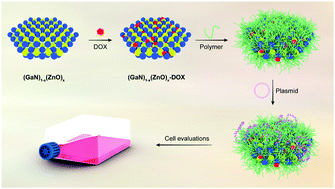Zn-rich (GaN)1−x(ZnO)x: a biomedical friend?†
Abstract
A Zn-Rich (GaN)1−x(ZnO)x nanostructure was synthesized with the assistance of a high-gravity technique in order to reduce the reaction time and temperature. The synthesized inorganic nanomaterial has been applied in both drug and gene delivery systems, and as the first fully inorganic nanomaterial, it was investigated in a comprehensive cellular investigation as well. In order to increase the potential bioavailability, as well as the interactions with the pCRISPR, the nanomaterial was enriched with additional Zn ions. The nanomaterial and the final nanocarrier were characterized at each step before and after any biological analysis via FESEM, AFM, TEM, FTIR and XRD. The polymer coated nanosystems were fully characterized, and their sustained DOX delivery were investigated as well as the comprehensive cytotoxicity investigations on HEK-293, PC12, HepG2 and HeLa cell lines after 24, 48 and 72 h of treatment, which showed that the nanomaterial had acceptable and very good cell viability at a minimum concentration of 0.1 μg mL−1 and a maximum concentration of 10 μg mL−1. Also, after coating with chitosan and alginate, the relative cell viability on all of the cell lines increased in the range of 2.7% to 18.9%. In the next step, the nanosystems were tagged with pCRISPR to analyze the potential application in the co-delivery of drug and gene. The confocal laser scanning microscopy (CLSM) images of the 4′,6-diamidino-2-phenylindole (DAPI) stained DOX showed that the Zn-rich (GaN)1−x(ZnO)x nanosystem has lower cellular density than the chitosan and alginate coated nanosystems. However, all of them showed acceptable and suitable localization of DOX into the nanostructure and the into the cells after the drug delivery procedure, along with sustained behaviors at different pH values. Furthermore, the CLSM images of HEK-293 and HeLa cell lines showed the successful delivery of pCRISPR into the cells, and the enhanced green fluorescent protein (EGFP) reached up to 9.3% for the HeLa cell line, which is a record by itself. In addition, the exact morphologies of the nanosystems before and after drug and gene delivery procedures were investigated via FESEM and TEM, and the results showed that in the presence of polymer coating, the morphology of the substrates was intact.



 Please wait while we load your content...
Please wait while we load your content...